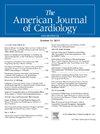Impact of Multiarterial versus Single Arterial Coronary Bypass Graft Surgery on Postoperative Atrial Fibrillation
IF 2.3
3区 医学
Q2 CARDIAC & CARDIOVASCULAR SYSTEMS
引用次数: 0
Abstract
The effect of multiarterial (MA) versus single arterial (SA) coronary bypass graft surgery on postoperative atrial fibrillation (POAF) was not investigated. From May 2017 to May 2024, the patients with CYP2C19*2 or *3 allele receiving coronary artery grafting and postoperational aspirin 100 mg/day and clopidogrel 75 mg/day were retrospectively reviewed and assigned to the MA or SA group. The primary end point was the incidence rate of POAF in the first week. The secondary end points were POAF burden, platelet aggregation, systemic immune-inflammation index, and heart rate variability. The study included 58 cases in the MA group and 174 cases in the SA group. The incidence of POAF was 17% in the MA group, contrasting with 42% in the SA group (hazard ratio 0.353, 95% confidence interval 0.218 to 0.569, p = 0.0012). A lower POAF burden was observed in the MA group than in SA group (2 [1 to 5] vs 10 hours [6 to 20], p = 0.02). Platelet aggregation (arachidonic acid: 46 ± 10% vs 56 ± 8%, p <0.01; adenosine diphosphate: 58 ± 17% vs 75 ± 13%, p <0.01) and inflammation response index (neutrophil to lymphocyte ratio: 26 ± 4 vs 28 ± 5, p = 0.006; systemic immune-inflammation index: 5,019 ± 771 vs 5,382 ± 1,204, p = 0.032) was notably lower in MA group than those in SA group at 1 day after coronary artery bypass grafting. Holter electrocardiogram showed a higher heart rate variability value in the SD of the normal-to-normal RR intervals and decreased low frequency/high frequency ratio in the MA group. In conclusion, MA was associated with a lower incidence rate of POAF and paralleled with a lower atrial fibrillation burden, platelet aggregation, and inflammation reaction and a higher parasympathetic nerve tone than the SA regimen.
多动脉与单动脉冠状动脉旁路移植手术对术后心房颤动的影响。
多动脉(MA)与单动脉(SA)冠状动脉旁路移植手术对术后心房颤动(POAF)的影响尚未进行研究。自2017年5月至2024年5月,对CYP2C19*2或*3等位基因患者接受冠状动脉移植术和术后阿司匹林100毫克/天和氯吡格雷75毫克/天进行回顾性回顾,并将其分配到MA组或SA组。主要终点是第一周的 POAF 发生率。次要终点为 POAF 负担、血小板聚集、全身免疫炎症(SII)指数和心率变异性(HRV)。研究纳入了 58 例 MA 组病例和 174 例 SA 组病例。MA 组的 POAF 发生率为 17%,而 SA 组为 42%(危险比:0.353;95% 置信区间:0.218 至 0.569,P=0.0012)。在 MA 组观察到的 POAF 负担低于 SA 组(2 h [1, 5] 对 10 h [6, 20], P=0.02)。血小板聚集(花生四烯酸,46%±10% 对 56%±8%,P
本文章由计算机程序翻译,如有差异,请以英文原文为准。
求助全文
约1分钟内获得全文
求助全文
来源期刊

American Journal of Cardiology
医学-心血管系统
CiteScore
4.00
自引率
3.60%
发文量
698
审稿时长
33 days
期刊介绍:
Published 24 times a year, The American Journal of Cardiology® is an independent journal designed for cardiovascular disease specialists and internists with a subspecialty in cardiology throughout the world. AJC is an independent, scientific, peer-reviewed journal of original articles that focus on the practical, clinical approach to the diagnosis and treatment of cardiovascular disease. AJC has one of the fastest acceptance to publication times in Cardiology. Features report on systemic hypertension, methodology, drugs, pacing, arrhythmia, preventive cardiology, congestive heart failure, valvular heart disease, congenital heart disease, and cardiomyopathy. Also included are editorials, readers'' comments, and symposia.
 求助内容:
求助内容: 应助结果提醒方式:
应助结果提醒方式:


